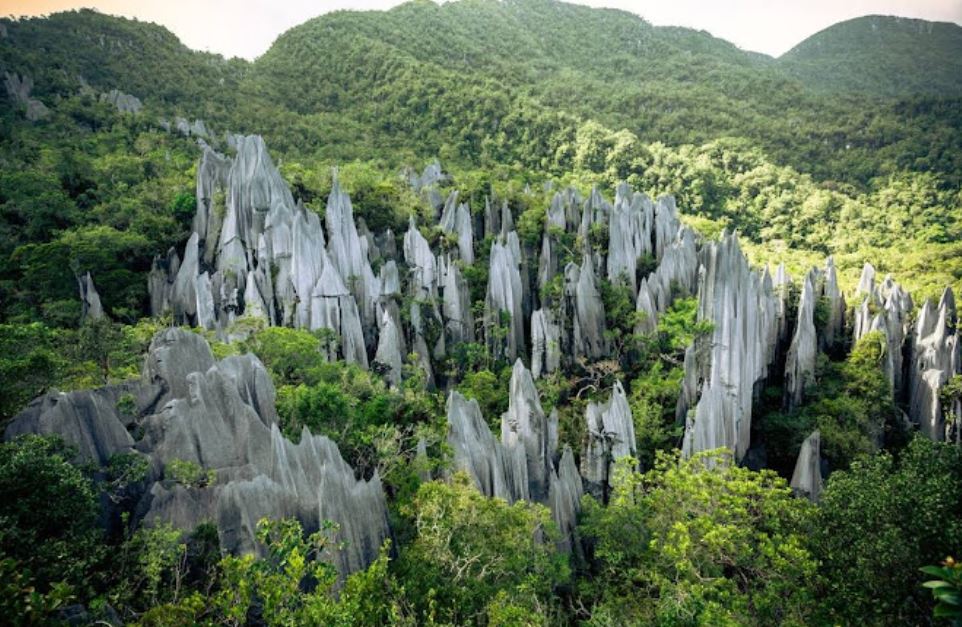news
Ivory Hills China real or fake? (Revealed)

We found a viral picture and a video of a beautiful place called Ivory Hills China, but it is fake and does not exist.
The location is said to be in Guilin, Guangxi, China. That is not correct; the image and video are generated by AI.
They shouldn’t be taken seriously.

Is Ivory Hills China Real or Fake?
The Ivory Hills China is fake.
An image that has a slight resemblance is the Gunung Mulu National Park.

Gunung Mulu National Park in Malaysian Borneo is a protected rainforest.
It’s famous for its dramatic peaks and caves, such as the massive, bat-infested Deer Cave.
The cave leads to Eden, a hidden valley and waterfall surrounded by limestone cliffs.
Gunung Api’s Pinnacles are tall, jagged limestone formations with steep trails and rare orchids.
Gunung Mulu Mountain’s summit offers panoramic views of the park.
Impact of Fake AI Images and Pictures
In the era of rapid technological advancements, artificial intelligence (AI) has opened up new possibilities in various fields, including image generation.
With the help of sophisticated algorithms and deep learning techniques, AI can now create incredibly realistic and convincing images that are indistinguishable from genuine photographs.
However, this advancement has also given rise to concerns regarding the proliferation of fake AI images and their potential implications on society.
The Emergence of Fake AI Images
The development of AI-generated images stems from the rapid progress in machine learning and specifically the field of generative adversarial networks (GANs).
GANs consist of two neural networks: a generator network that creates synthetic images and a discriminator network that differentiates between real and fake images.
Through a continuous feedback loop, GANs can refine the generator’s output to create increasingly realistic images.
This breakthrough has led to the emergence of fake AI images, capable of mimicking the complexity and visual fidelity of real-world photographs.
Uses and Applications
Fake AI images have found applications in various domains.
In entertainment and media, they are utilized for creating realistic computer-generated imagery (CGI) in movies, video games, and virtual reality experiences.
AI-generated images also serve as valuable tools for designers, architects, and artists, allowing them to visualize concepts, explore possibilities, and experiment with different aesthetics.
Moreover, fake AI images have implications for advertising and marketing, where they can be used to create visually appealing and attention-grabbing content.
Companies can simulate product shots or showcase prototypes before actual production, saving time and resources.
However, these applications raise ethical concerns regarding transparency and the potential for misleading consumers.
Concerns and Challenges
The proliferation of fake AI images poses significant challenges and concerns. One major issue is the potential for misuse and deception.
With AI’s ability to create highly realistic images, the line between real and fake becomes increasingly blurred.
This raises concerns about the spread of misinformation, as AI-generated images can be used to fabricate evidence, create fake identities, or manipulate historical records.
Another concern revolves around privacy and consent. AI models are often trained on massive datasets, including publicly available images.
This raises questions about the ownership and usage rights of personal images and the potential for privacy violations when these images are used to create fake AI-generated content.
Additionally, fake AI images can perpetuate harmful stereotypes and biases.
AI algorithms learn from the data they are trained on, and if the training data is biased, the generated images may reflect those biases.
This can reinforce existing prejudices and discriminatory representations in society.
Ethical Responsibility
The creators and users of AI-generated images bear a responsibility to use this technology ethically. Transparency is paramount in distinguishing between real and fake images.
Developers should label or watermark AI-generated content to ensure clarity and prevent its malicious use.
Safeguards must be in place to combat the misuse of AI-generated images.
Educating the public about the existence and capabilities of fake AI images is essential to promote media literacy and critical thinking.
Additionally, the development of advanced detection methods and algorithms can aid in identifying and flagging fake AI images.
Regulation and policy frameworks can play a crucial role in addressing the ethical challenges posed by fake AI images.
Governments and organizations should work together to establish guidelines and standards that govern the creation, use, and dissemination of AI-generated content.
Wrap Up
Fake AI images represent a remarkable technological advancement with significant implications for society.
While they have practical applications and creative potential, ethical concerns surrounding their misuse and deceptive nature must be addressed.
FAQ
The Ivory Hills in China is rumored to be located in Guilin, Guangxi, China.
Ivory Hills China is fake and it was created using A.I. Don’t take the pictures and videos seriously.












